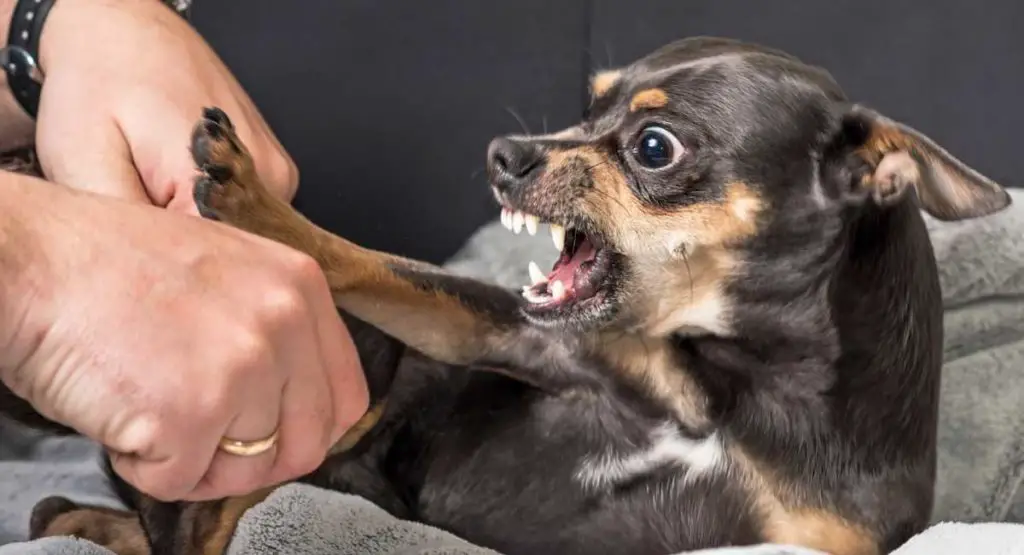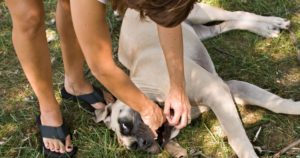If you feel that your dog may be exhibiting aggressive tendencies, then you’ve probably been researching how to stop aggressive dog behavior. Aggression comes in different forms and typically includes growling, snapping, biting, barking, and charging at people or other animals.
The first step is looking for signs of aggression in your dog, determining the cause, and identifying who or what the aggression is directed at. Many behaviors are warning signs that a dog may become aggressive, and it’s important to be aware of these to avoid attacks.
While some dog breeds may have a reputation for being more aggressive, any breed can be prone to aggression and may need the help of a professional animal behaviorist or training classes. These professional resources can help with obedience, calming aggressive behavior, figuring out triggers for aggression, and minimizing those triggers.
Reasons Why Dogs Can Behave Aggressively
It’s important to learn the warning signs of aggressive behavior to help avoid attacks. Usually, dogs display aggressive characteristics before they bite, like growling, barking, snapping, lunging, or nipping.
Your dog may display aggression towards people or other animals. The first step is figuring out what’s triggering their aggression. For example, is it because you approach your dog when they’re eating food or when you try taking things away from them? Once you pinpoint the cause of the unwanted behavior, you can then work on modifying their behavior.

Here are some of the common causes of aggressive behavior in dogs:
Possessive Aggression
This is where a dog may become aggressive because it feels possessiveness over something, or it thinks an object may be taken away from it, like a bone or a doggy chew toy. Often, dogs will be possessive over their food as a natural instinct of survival, and training may be needed for both owner and dog to deal with this.
There may also be relevant history to this type of aggression, such as an abandoned dog that had to compete with others for scarce resources, or a dog that a previous owner has abused. Pinpointing the aggression triggers helps you to remedy that trigger.
Dominance Aggression
Some dogs will naturally want to dominate other dogs, leading to dominance-based aggressive behavior like nipping. Working with animal behaviorists can help train your dog not to do this.
Fear-based Aggression
Dogs can attack or behave aggressively when they are scared, particularly if they feel cornered. In these instances, it’s necessary to figure out what makes the dog fearful, such as a person, loud noise, or something linked with the past.
Protective Aggression
Similar to possessive aggression, with protective aggression, a dog may feel that something it cares about is at risk and wants to protect it by showing aggression as a warning sign. If the situation continues to escalate, the dog may attack.
Often, animals like dogs will be very protective over their young if they feel threatened, but this could also extend to their owners. Building trust is an important aspect of training to ensure the dog understands that they don’t need to be protective because you won’t harm them or their puppies.
Frustration-based Aggression
Dogs are animals, and animals do not like to be overly restricted from exercising and running around. Dogs cooped up in confined spaces all day will have pent-up energy, leading to high levels of frustration and poor health outcomes.
Dogs kept in a small yard with a barking dog next door could also become frustrated. Additionally, dogs chained on a leash and not allowed to run free can also feel very restricted and agitated. When a dog feels severely restricted and has too much energy, they can become aggressive.
Learning to read the signs of frustration and knowing what a dog needs for a healthy lifestyle and daily routines can help avoid this type of frustration-based aggression.
Illness-based Aggression
Sometimes when dogs are ill or injured, they can become aggressive. Conditions like rabies can make dogs behave aggressively, and it’s important to ensure that your dog receives all necessary health checkups and recommended vaccines to avoid serious illnesses. Dogs can also become aggressive if they are hurt as a self-defense mechanism to avoid pain.
Sexual Aggression
It’s a natural animal instinct for males to compete for the attention of females. If several dogs are together, they may do this and become aggressive. It’s good to be aware of suitable gender matches when choosing dogs to keep together in a household. Having your dogs either neutered or spayed can also help avoid some of this hormone-based aggression.
Territorial Aggression
Many dogs will become defensive of areas that they consider their territory, such as their homes. Knowing this as an owner will help you preemptively deal with and mitigate this type of aggression.
That’s why, with most animals, animal behaviorists will advise that you always introduce dogs on neutral territory and not take a new dog onto another dog’s property.
How to Stop Aggressive Dog Behavior
Once you’ve pinpointed the cause or trigger of aggressive behavior for your dog, the next step is to look at how to treat, address, and stop aggressive behavior.
This will generally include training or teaching your dog about the type of behavior you want from them through encouragement, incentives, and positive reinforcement. Often, you will need to work on obedience training as part of the overall strategy.
It’s best to consult your vet if you’ve noticed sudden or unusual aggression from your fur baby, as it could be indicative of an illness, injury, or other health condition. If that is the case, your dog may have to take medication to help treat the cause. If the vet can’t find a medical reason for your dog’s aggression, you may need to work with a professional dog trainer or behaviorist to help train your dog and give you exercises to practice at home.
While you may intuitively think that punishing a dog for its aggressive behavior is the right way to train a dog, that approach may not be very effective. In fact, hitting a dog for their aggression may lead to more aggression. A professional will help you work with a dog, as a psychologist would work with a human, by finding ways to work with the animal through positive reinforcement rather than instilling fear.
In some cases, your dog may also need to take medication to help control their anxiety or aggression. Most importantly, you’ll need to work with specialists to avoid triggers that create aggressive behavior.
Can Aggressive Behavior in Dogs Be Cured?
Many people with aggressive dogs are keen to know whether there’s anything that can be done to stop aggressive dog behavior. You may have tried several experts, but nothing has worked. While most interventions aimed at reducing or eliminating aggression will be successful, sometimes, there may be nothing else you can do.
You may need to try and avoid triggers to manage the situation. For example, if you know that a particular person triggers your dog, consider limiting contact with that person around your dog. Or, if you know that your dog is sensitive to being touched on their back, then avoid doing that at all costs.
It’s also wise to err on the side of caution if you know your pet is subject to bouts of aggression by putting safety measures in place. After all, you wouldn’t want anyone or any other pet to get injured. That may mean always walking your dog on a leash or even purchasing a muzzle for your dog.
Calming Canines: Final Thoughts on Stopping Aggression in Dogs
Like all animals, dogs can be unpredictable, and they can display aggressive behavior. Working with experts like your vet and behavioral specialists can help you develop a strategy to stop aggressive dog behavior.
The first part of this process is to try and pinpoint what triggers aggressive behavior in your dog – whether it’s out of a sense of protectiveness over its food or if it has sensitivities to being touched. This may include medication and training sessions, as well as ongoing positive reinforcement of good behavior.
While many times, aggressive behavior can be minimized or avoided altogether, in some instances, these interventions may not work. Here you may need to resort to reducing triggers and managing aggression as best you can.






